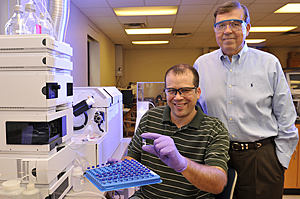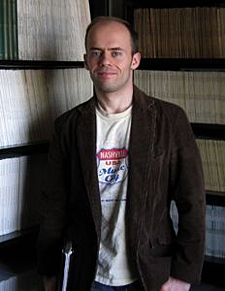ADVERTISEMENT
- Rozovsky wins prestigious NSF Early Career Award
- UD students meet alumni, experience 'closing bell' at NYSE
- Newark Police seek assistance in identifying suspects in robbery
- Rivlin says bipartisan budget action, stronger budget rules key to reversing debt
- Stink bugs shouldn't pose problem until late summer
- Gao to honor Placido Domingo in Washington performance
- Adopt-A-Highway project keeps Lewes road clean
- WVUD's Radiothon fundraiser runs April 1-10
- W.D. Snodgrass Symposium to honor Pulitzer winner
- New guide helps cancer patients manage symptoms
- UD in the News, March 25, 2011
- For the Record, March 25, 2011
- Public opinion expert discusses world views of U.S. in Global Agenda series
- Congressional delegation, dean laud Center for Community Research and Service program
- Center for Political Communication sets symposium on politics, entertainment
- Students work to raise funds, awareness of domestic violence
- Equestrian team wins regional championship in Western riding
- Markell, Harker stress importance of agriculture to Delaware's economy
- Carol A. Ammon MBA Case Competition winners announced
- Prof presents blood-clotting studies at Gordon Research Conference
- Sexual Assault Awareness Month events, programs announced
- Stay connected with Sea Grant, CEOE e-newsletter
- A message to UD regarding the tragedy in Japan
- More News >>
- March 31-May 14: REP stages Neil Simon's 'The Good Doctor'
- April 2: Newark plans annual 'wine and dine'
- April 5: Expert perspective on U.S. health care
- April 5: Comedian Ace Guillen to visit Scrounge
- April 6, May 4: School of Nursing sponsors research lecture series
- April 6-May 4: Confucius Institute presents Chinese Film Series on Wednesdays
- April 6: IPCC's Pachauri to discuss sustainable development in DENIN Dialogue Series
- April 7: 'WVUDstock' radiothon concert announced
- April 8: English Language Institute presents 'Arts in Translation'
- April 9: Green and Healthy Living Expo planned at The Bob
- April 9: Center for Political Communication to host Onion editor
- April 10: Alumni Easter Egg-stravaganza planned
- April 11: CDS session to focus on visual assistive technologies
- April 12: T.J. Stiles to speak at UDLA annual dinner
- April 15, 16: Annual UD push lawnmower tune-up scheduled
- April 15, 16: Master Players series presents iMusic 4, China Magpie
- April 15, 16: Delaware Symphony, UD chorus to perform Mahler work
- April 18: Former NFL Coach Bill Cowher featured in UD Speaks
- April 21-24: Sesame Street Live brings Elmo and friends to The Bob
- April 30: Save the date for Ag Day 2011 at UD
- April 30: Symposium to consider 'Frontiers at the Chemistry-Biology Interface'
- April 30-May 1: Relay for Life set at Delaware Field House
- May 4: Delaware Membrane Protein Symposium announced
- May 5: Northwestern University's Leon Keer to deliver Kerr lecture
- May 7: Women's volleyball team to host second annual Spring Fling
- Through May 3: SPPA announces speakers for 10th annual lecture series
- Through May 4: Global Agenda sees U.S. through others' eyes; World Bank president to speak
- Through May 4: 'Research on Race, Ethnicity, Culture' topic of series
- Through May 9: Black American Studies announces lecture series
- Through May 11: 'Challenges in Jewish Culture' lecture series announced
- Through May 11: Area Studies research featured in speaker series
- Through June 5: 'Andy Warhol: Behind the Camera' on view in Old College Gallery
- Through July 15: 'Bodyscapes' on view at Mechanical Hall Gallery
- More What's Happening >>
- UD calendar >>
- Middle States evaluation team on campus April 5
- Phipps named HR Liaison of the Quarter
- Senior wins iPad for participating in assessment study
- April 19: Procurement Services schedules information sessions
- UD Bookstore announces spring break hours
- HealthyU Wellness Program encourages employees to 'Step into Spring'
- April 8-29: Faculty roundtable series considers student engagement
- GRE is changing; learn more at April 15 info session
- April 30: UD Evening with Blue Rocks set for employees
- Morris Library to be open 24/7 during final exams
- More Campus FYI >>
10:04 a.m., Jan. 29, 2010----Research performed by Matthew Ginder-Vogel, associate scientist in the Delaware Environmental Institute, Gautier Landrot, a graduate student in environmental soil chemistry at the University of Delaware, and Donald L. Sparks, S. Hallock du Pont Chair of Soil and Environmental Chemistry and director of the Delaware Environmental Institute, is featured in this month's special issue of Environmental Science and Technology, the premier environmental science and engineering journal in the world.
Ginder-Vogel, who recently accepted a position as analytical manager at Calera Corp., a carbon sequestration start-up company in California, is also a guest editor of the issue, which is focused on biogeochemical redox processes and their impact on the fate and transport of environmental contaminants.
He collaborated with Thomas Borch, assistant professor of environmental chemistry and biogeochemistry in the department of soil and crop sciences at Colorado State University; Kate Campbell, a research biogeochemist at the U.S. Geological Survey in Colorado; Environmental Science and Technology associate editor Ruben Kretzschmar, a professor of soil chemistry in the Institute of Biogeochemistry and Pollutant Dynamics (ETH), Zurich, Switzerland; and three other scientists to select publications that fit the research theme of redox biogeochemistry.
“The Jan. 1, 2010 issue presents a series of experimental and theoretical research articles covering multiple scales that illustrate why biogeochemical redox processes are so important in controlling the fate and transport of both organic and inorganic contaminants in the environments,” wrote Borch, Campbell and Kretzschmar in their introduction to the issue. “The research articles are accompanied by two critical reviews: one providing a more general overview of the field, and the other addressing energetic constraints on terminal electron accepting processes in anoxic environments.”
One of those reviews, written by Ginder-Vogel, Borch, Campbell and Kretzschmar, along with Andreas Kappler of the Center for Applied Geoscience at the University of Tübingen, Germany, Philippe VanCappellen of the School of Earth and Atmospheric Sciences at the Georgia Institute of Technology and Andreas Voegelin Eawag of the Swiss Federal Institute of Aquatic Science and Technology, is a general overview of the research area, discussing how electron flow controls contaminant dynamics.
The review, entitled “Biogeochemical Redox Processes and their Impact on Contaminant Dynamics,” shares the latest advances in the scientific understanding of biogeochemical redox processes and their impact on contaminant fate and transport and raises research questions that still need to be addressed.
Work that Ginder-Vogel did while a post-doctoral researcher at UD was funded by Delaware's National Science Foundation EPSCoR grant, another NSF grant and a grant from the U.S. Department of Agriculture.
“Given the diversity and importance of biogeochemical redox processes, it is clear that this will continue to be an active, exciting area of research,” wrote Borch, Campbell and Kretzschmar in their introduction to this issue of the journal.
The idea for a special issue of the journal came to Kretzschmar when he participated in a special session on biogeochemical redox processes in soils and sediments at the Fall 2008 American Chemical Society meeting in Philadelphia, organized by Ginder-Vogel, Borch and Campbell.
“Multidisciplinary collaborations like this, among scientists and engineers from institutions across the U.S. and Europe, are exactly what should be happening in leading-edge environmental research,” said Sparks. “DENIN is thrilled to be involved in such prominent partnerships.”
Ginder-Vogel's research has focused on biogeochemical metal cycling since he earned his doctorate in the soil and environmental biogeochemistry research group at Stanford University, which is led by Scott Fendorf, who earned his doctorate in Sparks' research group at the University of Delaware and is a recipient of a University of Delaware Presidential Citation for Outstanding Achievement.
Ginder-Vogel's paper entitled “Kinetic and Mechanistic Constraints on the Oxidation of Biogenic Uraninite by Ferrihydrite,” which focuses on the interaction between biologically precipitated uraninite and iron oxide minerals in near-surface environments, also appears in the journal.
“My paper explores the unique aspects of uranium and iron interactions,” said Ginder-Vogel. “I look forward to continuing to answer difficult questions about environmental contaminants in my future research.”
Landrot's paper, “Kinetics of Chromium(III) Oxidation by Manganese(IV) Oxides Using Quick Scanning X-ray Absorption Fine Structure Spectroscopy (Q-XAFS),” discusses his use of a new quick-scanning X-ray absorption spectroscopy (Q-XAS) technique developed by Ginder-Vogel, Landrot and Sparks to look at rates of chromium transformation by Mn oxide, a common soil mineral.
Article by Katie Ginder-Vogel




